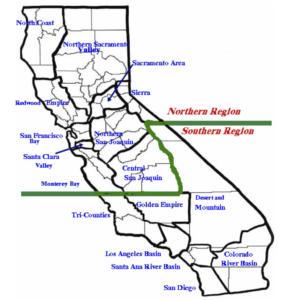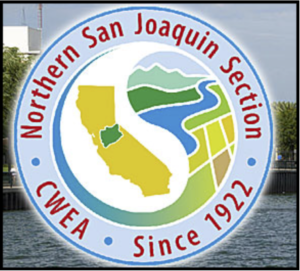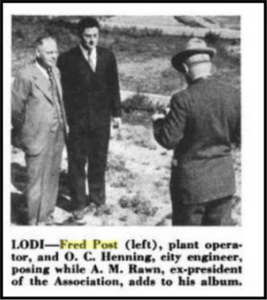 “The CWEA has divided the state into 17 geographical Local Sections to accommodate its members’ needs across the State in a local format. Local Sections are grouped into two regions, Northern and Southern, and have quarterly Regional Committee meetings to discuss regional or statewide issues, and to share information with other Local Sections.
“The CWEA has divided the state into 17 geographical Local Sections to accommodate its members’ needs across the State in a local format. Local Sections are grouped into two regions, Northern and Southern, and have quarterly Regional Committee meetings to discuss regional or statewide issues, and to share information with other Local Sections.
Each CWEA member belongs to at least one Local Section, and many have elected to belong to one or more additional Local Sections (additional fees apply).
Local Sections provide a multitude of services for wastewater professions in their geographical areas such as training events, exhibits, awards programs, newsletters, website information, networking opportunities, and certification preparation assistance.”
The CWEA History Committee is periodically asked about the beginnings of CWEA’s Local Sections. Over the last few years, the History Committee has received the following types of questions regarding our Local Sections: When did the Local Sections start? Which CWEA Local Section was first? How were the CWEA Local Sections formed? To answer these questions, the History Committee researched the Association archives to produce this article commemorating the 80th anniversary of the founding of the first CWEA Local Section.
 According to the minutes of the Eleventh Annual Conference in Santa Barbara, the California Sewage Works Association’s (CSWA) Governing Board discussed authorizing the formation of Local Sections on September 6, 1938. The CSWA’s records show that the first Local Section was fully operational as of November 7, 1938. So, we consider 1938 as the official start date for CWEA’s Local Sections.
According to the minutes of the Eleventh Annual Conference in Santa Barbara, the California Sewage Works Association’s (CSWA) Governing Board discussed authorizing the formation of Local Sections on September 6, 1938. The CSWA’s records show that the first Local Section was fully operational as of November 7, 1938. So, we consider 1938 as the official start date for CWEA’s Local Sections.
The actual CSWA Constitution & Bylaws amendment that established the rules for the formation of Local Sections was adopted on September 18, 1939 at the Twelfth Annual Fall Convention in Oakland. This makes it a little confusing for the researcher because at first glance it appears that Local Sections did not exist until after the amendment was approved. However, a careful review of the records indicate that authorization was granted with the formal “codification” of the Local Section formation requirements as a follow-up action at the next CSWA annual convention in 1939.
As might be expected, the 1939 requirements for the formation and operation of a Local Section resemble the current requirements with some interesting exceptions: Membership in a Local Section was limited to CSWA members who were in the Local Section geographic area, no CSWA member could be a member of more than one section at a time, and there was no category of “Local Section Subscriber”.
 The San Joaquin Section (now known as the Northern San Joaquin Section) was officially the first CWEA Local Section to be formed in 1938. Thus, the current Northern San Joaquin Section has the distinction of being “first”. At start-up, the San Joaquin Section had a total of fifteen paid members and Section dues were $0.25 per year and CSWA dues were only $2.00 per year!
The San Joaquin Section (now known as the Northern San Joaquin Section) was officially the first CWEA Local Section to be formed in 1938. Thus, the current Northern San Joaquin Section has the distinction of being “first”. At start-up, the San Joaquin Section had a total of fifteen paid members and Section dues were $0.25 per year and CSWA dues were only $2.00 per year!
Interestingly, the Northern San Joaquin Section Logo (above) indicates that it was founded in 1922 – six years before the CSWA was founded in 1928! There is no record in the archives of any Local Section activities prior to 1938, however the CWEA History Committee speculates that the 1922 date might somehow be related to the 1923 Fresno AWWA convention where the idea of a California sewage works association was originally proposed.
Discussions regarding the formation of the San Joaquin Section started in 1937 with William T. Ingram, Sanitary Engineer for the San Joaquin Health District, taking the lead in organizing the section. William T. Ingram was very active in the CSWA and served on several Association Committees in the 1930’s and also served as the CSWA Secretary-Treasurer (1940-1941). The idea of establishing a Local Section was the result of Ingram’s role in developing the program for the CSWA’s Ninth Annual Spring Conference held in Stockton on April 23rd and 24th 1937. William T. Ingram Chaired the 1937 Spring Conference and along with Lyle Payton, Fred West, Kenneth Brown (all from the City of Stockton), Fred Post (City of Lodi), developed the conference program.
Ingram, in his role as Sanitary Engineer for the San Joaquin Health District, had a good understanding of the training needs for the wastewater personnel in his district. He also understood the difficulty that the local wastewater personnel had in securing funding for travel and training thanks to his serving on the CSWA publicity committee. The success of the 1937 Spring Conference technical program demonstrated that the staff of the cities in the northern San Joaquin Valley area had the ability to develop good technical training sessions. Thus, the idea of creating a “Local Section” of the CSWA to provide affordable and accessible training was born and William T. Ingram organized discussions in his district that resulted in the Local Section proposal being presented to the CSWA Board at the 1938 Annual Fall Convention.
The CWEA History Committee recently received a copy of a January 1938 San Joaquin Health District Bulletin from William T. Ingram’s office that mentions the proposal to form the San Joaquin Section and the appointment of Local Section Committees in December 1937 to prepare for subsequent approval of the Local Section by the CSWA Board. It is interesting to note that the key committee positions were filled by the members who developed the 1937 Spring Conference program.
Per the bulletin and the CSWA archives, the first Local Section President was Fred Post, chief operator of the City of Lodi’s activated sludge plant.

Fred Post, City of Lodi, CWEA’s First Local Section President, San Joaquin Section, 1938 (photo from 1937)
The original San Joaquin Section Boundaries were close to the boundaries of the current Northern San Joaquin Section; however, the San Joaquin Section did hold a meeting in Sacramento in 1941, but there is no indication that Sacramento was considered a geographical part of the San Joaquin Section.
For the most part, the San Joaquin Section’s training meetings rotated between the cities of Turlock, Manteca, Tracy, Stockton and Lodi in the early years (1938-1943). The training was very similar to today’s Local Section dinner meeting format; an expert on a technical area was invited to make an hour-long presentation to the group during an evening dinner meeting, followed by questions and answers. Daytime operations training sessions were also offered. The presenters came from within the section and from outside of the section (mainly the Bay Area). Topics covered a range of plant operations issues. This training format was quite popular according to the Section reports and the San Joaquin Section initially held nine meetings in 1939 with “fine attendance” from local wastewater personnel.
The outbreak of World War II impacted the frequency of CSWA meetings – many CSWA members and leaders joined the military and gasoline rationing impacted the ability to travel. In 1943, the number of statewide CSWA conferences/conventions was temporarily cut to one per year to reduce travel in compliance with wartime requirements.
The San Joaquin Section started out holding nine monthly meetings in 1938 and peaked with twelve meetings during 1940. The war had a significant impact on the frequency of the San Joaquin Section’s meetings. The number of monthly meetings dropped to four in 1942 and the meetings ceased around 1943. In 1942, San Joaquin Section leader William T. Ingram joined the Office of Civilian Defense as a captain and was stationed in San Francisco. This impacted San Joaquin Section organizational activities as the Section lost a key supporter at the San Joaquin Health District (Ingram served as a sanitary engineer in Yugoslavia after the war and later became a professor of public health engineering at New York University). Thanks to World War II, there would be no CSWA Local Section activity for the next six years (1943-1949).
The post-war years were marked by unprecedented growth in California leading to the construction and upgrade of new wastewater treatment facilities throughout the state. The need to train wastewater personnel to staff and operate facilities once again became a priority – discussions about Local Sections as a means of increasing training access and opportunities resumed and the leaders of the dormant San Joaquin Section began to talk about restarting the Section in 1948-1949.
December 1949 marked the “restart” of the San Joaquin Section under the leadership of F. Wayland Jones (City of Stockton). Jones was an original member of the San Joaquin Section and served on the 1938 San Joaquin Section Membership Committee. CSWA President Ray Ribal had this to say about the restart of the San Joaquin Section in December 1949:
“The San Joaquin Section organized prior to World War II by Bill Ingram, and so successful, has been reactivated. Wayland Jones, Herman Holman and Don Layson were elected chairman, vice-chairman, and secretary-treasurer, respectively, of the newly activated section Wednesday evening, December 14, 1949. There were twenty-five in attendance at the meeting.
If you are in Stockton on the third Wednesday of the month, give Wayland Jones a ring; he will be glad to welcome you to the Section meeting.
Winter meetings of the Section are to lean heavily toward the schooling of operators, while this coming summer a plant visitation program is planned.
Herb Foster, who attended the meeting, predicts a bright future for the San Joaquin Section and many new members.
To the officers and members of the San Joaquin Section CSWA go the best wishes of CSWA for success and professional fellowship.”
The San Joaquin Section and its training events was successful, and it continues successfully as the current CWEA Northern San Joaquin Section (NSJ), still holding training meetings on the third Wednesday of the month, rotating between cities in the NSJ Section as originally established by the Section leaders in 1938.
In the December 1949 Association newsletter, CSWA President Ray Ribal asked the question, “Who’s next?” under the heading:
“No. 2 Section??
Where will it be? San Francisco Peninsula – San Diego— Los Angeles—Bakersfield? We heard rumors that Ben Benas and Walter Siberbaurer are thinking about a Peninsula Section.”
Who’s next? The CWEA History Committee knows!
The answer to the question of which Local Section was the “Number 2 Section” will appear in a future article along with the story of CWEA Local Section growth and development in the 1950’s.